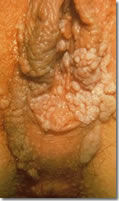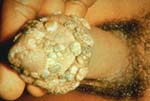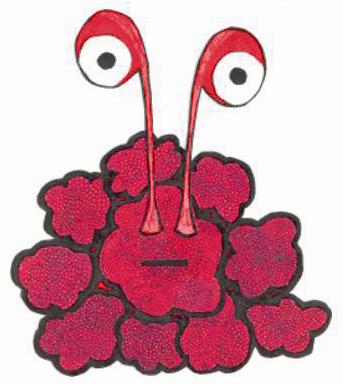As former a sexual health educator and current sexuality studies professor, I meet students whose ideas about sexually transmitted diseases (STDs) have been shaped by the ‘scary slideshow’: that series of full-color, close-up shots of the worst infections.
(Not safe for work–explicit images of STDs)


Are these images representative?
Consider the likely socioeconomic status of the men and women whose genitals are used to ‘educate’ the rest of us. Think about the guy who takes out his penis each time he needs to urinate, sees yet another new wart growth and doesn’t seek treatment — isn’t it likely that he has little or no access to healthcare, never received comprehensive sexual health education, and may have larger life stresses (poverty, hunger, homelessness) that have led him to make STD treatment a low priority in his life?
Some sexual health programs have tried to temper these scare tactics by using STD cartoons in place of graphic photos. For example, the University of Bath website features “Warty”:

However cute “Warty” may be, I’m not sure that the University of Bath students are any more likely to understand their real risks of contracting HPV.
The ‘scary slideshow,’ though, prevails as the dominant series of educational images. But, as horrified as students are by these images of disfiguring diseases, they are also reassured by them. After all, it must be easy to avoid contracting a STD — just avoid having sex with people who have ‘cauliflowers’ of warts sprouting from their genitalia. The truth about these epidemics is far scarier: most of us who are infected are undiagnosed, diagnosed but unclear about risks of transmission, asymptomatic and believing our lack of symptom equals being cured, or in denial about the reality of our symptoms (e.g., “Isn’t that just a pimple?”).
If we want to accurately strike fear into the hearts of sexually-active individuals, then we might want to develop a STD awareness campaign that visually speaks the truth. Imagine a series of tasteful nude images of beautiful, sexy men and women whose genitals are clearly devoid of sores, lesions, and warts: tag lines below each photo might read “I don’t know that I’m infected with genital herpes” or “I know I have cervical HPV but my doctor never told me I’m contagious.”
A few websites post PG-13 versions of these types of images to accompany posts about sexually transmitted infections:
But, it may take more explicit images to drive home the point that no matter how ‘healthy’ a potential partner’s external genitalia appear to be, s/he might still be infected.
——————————





Comments 38
sarah — February 23, 2009
This is the whole other layer to what some call the HPV epidemic and the spread of genital herpes and that is the fact that most doctors don't test for HPV and herpes (and many will resist doing so) meaning most asymptomatic individuals have no idea they're infected. The stigma associated with these infections is often perceived to be more significant than the physical effects - odd when we consider the money that is poured into cervical screening. Creating an awareness campaign that doesn't further stigmatize those already infected is a huge challenge and something the above fails to do.
adina — February 23, 2009
Sarah raises a good point. As a proponent of de-stigmatizing STDs, I've devoted much of my professional career to this topic; I've also been open about my cervical HPV infection and personal experiences with STD stigma. At the same time, I'm an advocate for accurate sexual health education. This post focused on the later, but I agree that we must also push for a campaign that removes the moral and social stigma from those who are already infected. Is it possible that showing attractive people with healthy-looking genitalia as being STD-infected is one step in weakening current STD stigma (which associate infections with being dirty, damaged, not-sexy)? An argument could be made that the 'scary' slideshow images not only promote misunderstandings about STD risk but also reinforce negative stereotypes about those who are living with STDs.
Katharine — February 23, 2009
When I got the scary slideshow in high school, the message didn't seem to be "don't sleep with someone whose junk looks like this" - instead it was "don't have [unprotected] sex or this could happen to you." Perhaps this sounds like a hazy distinction, but all I know is that we left the classroom feeling anything but "reassured."
Frankly, I'm not too concerned about attaching a stigma to individuals with STDs through the use of such slideshows. The same argument could be made against those ubiquitous posters of a smoker's lung, but those aren't going away any time soon.
But even if those images are somewhat exploitative, it's more important to startle teens into smart behavior. And unfortunately, I don't believe most teens would appreciate the message behind subtler images like the final one posted above. I can hear my kid nephew scoffing, "So what, am I supposed to act like EVERY girl I meet has an STD?" Well...yeah.
However, I do think that images of healthy-looking people rather than just a close-up of diseased genitalia have the potential to be very effective in reinforcing smart sex practices in adults. They are probably more likely to brush off that memory of grotesque genitalia when it's a decade old and they are presented with a perfectly unblemished specimen. So such a PSA campaign would be a sobering reminder and a new way to relate to what the Cavalcade of Venereal Disease first taught them in high school health class.
Katharine — February 23, 2009
This is somewhat of a tangent, but after I thought about the smoker's lung poster, I recalled how desensitized I became to its message after seeing it so many times. "Yes, yes - that's gross, don't smoke, whatever." And I went on to become a smoker because a cigarette a day was not going to turn my lungs into THAT.
Then I saw the PSA Yul Brenner filmed shortly before his death of lung cancer. (Most have probably seen it, but if not: here.) As grossed out as I was as a kid looking at that poster, it had NOWHERE near the impact on me that Brenner's words did when I first heard them in my 20s.
I know this isn't a post about anti-smoking campaigns, but the difference in tactics is quite similar and I thought it worth noting. Some people will respond better to the blatant shock value of a repulsive image; others will need something more sobering and subtle in order to relate to the matter at hand. As long as both are proven to be effective, they are valid methods of conveying a serious message and need to continue in order for the message to be received by the greatest number of people.
sarah — February 23, 2009
I agree that normalising STDs as above is important - I also think we under-utilise stats. Maybe some calculations along the lines of 'if you have unprotected sex with three partners you have a x% chance of contracting herpes.' We need to stop people from thinking that STDs happen to 'other' people.
As for HPV it is a toughie as it is so incredibly common. I do think the HPV vaccine represents in important step in making the connection between cervical cancer and STDs (i.e. true prevention) and would love to see more discussion around the fact that it is down to HPV being so common that we've got population-based screening programmes for cervical cancer.
NancyP — March 8, 2009
Some people with multiple condylomas (warts) are simply in denial or are scared or embarrassed - untreated disease isn't always related to poverty, etc. Men in particular are prone not to deal with it, as some are afraid that treating a lesion on the penis means amputation, and some with anal warts are afraid that they will be identified as gay/bisexual/punk/victim (their medical providers will certainly correctly classify them as having been MSM men who had/have sex with men, whatever the identification or circumstance was). I find it unfortunate that women who should know better (medical workers) feel ashamed of having an HPV infection - the scarlet H.
Personally, I'd be inclined to keep the scare picture, put an equivalent with a single small wart and a normal looking equivalent next to the scare picture, and state - all these people can transmit HPV to other people.
Azalea — March 8, 2009
I think if such tasteful ads as the one proposed above were used in combination of how something as beautiful as the "tasteful" picture could lead to something as ugly as the much more graphic one the point would be driven home of the importance of proection against HIV/AIDS. However the bulk of the conversation about sex ed is more about preventing unwanted pregnancies as if STDs don't occur much much more often than pregnancy and certainly much more than childbirth ever will. Considering that you make babies the same way you pass along or contract STDs/STIs if more of an emphasis was placed on how to prevent STDs/STIs and their realistic prevelance then we'd have far less unwanted pregnancy and STI/STD transmission via prevention.
hexy — March 10, 2009
Sarah:
Maybe some calculations along the lines of ‘if you have unprotected sex with three partners you have a x% chance of contracting herpes.’
I've seen a poster aimed at gay men along those lines. It says something like "If you've had unprotected sex with eight men, chances are one of them was HIV positive."
SKHC — April 15, 2009
Much more comprehensive education of K-12 is needed but then it needs more advanced training in 9-12 and in college. Too many kids get the sex ed class once, it's too basic and never repeated. Or they don't get it again when they are young adults who can handle more depth. I work for a healthcare supply company who is the only company in our space catering to k-12 and colleges who offers a full line of sex education and sexual health products. I think more of us need to do our part to ensure these products are available to teachers, school nurses, phys. ed instructors, coaches, and parents.
Sociological Images » Guest Post: Naomi Wolf On The Beauty Myth — July 20, 2009
[...] out in 2008. You can see an earlier post of hers, about sexually transmitted disease and stigma, here. tags: beauty, bodies, capitalism, gender| Permalink| Comments (0) What Do People [...]
adjanae — December 5, 2009
people need to help the world instead of having sex wit each other because it's to many diseases and it's sad.
Guest Post: Something Stinks…About This GlaxoSmithKline Ad » Sociological Images — March 23, 2010
[...] posts by Adina include her thoughts on how STDs are represented visually in sex education (NSFW), the HPV vaccine for boys, and the beauty [...]
Dialurdoctor Medrx — July 14, 2011
Now its very easy to contact with doctor .http://www.dialurdoctor.com/
Choi_carvz — August 8, 2011
there is something in the skin of my penis in which at first it was just a small boil in my penis....but one day as i sleep, i felt that it hurts when i sleep in the form of planking and at morning i,d seen that it became larger and now it has a white color blood...i don't know why this happen to me...i wasn't able to have sex with someone...
can u help me to cure this one...pls..?
xxnxx — June 4, 2020
Is using a copyright material as a reference to write articles illegal?
Kasey Sk — June 25, 2020
These are horrific pictures.Everyone must be 9apps safe and secure (Apps
deolsunny533 — November 27, 2020
I read this article! I hope you will continue to have such articles to share with everyone! thank you!
nny53 — January 4, 2021
I read this article! I hope you will continue to have such articles to share with everyone! thank you! https://get-9apps.com/download/ https://cartoonhd.onl
deounny533 — January 4, 2021
I read this article! I hope you will continue to have such articles to share with everyone! thank you! 9apps cartoonhd
nofail — February 19, 2021
i read this article thanks for info ATF Turbo Box Latest
nofail — February 19, 2021
nice good work admin 9Apps APK new version
nofail — February 19, 2021
nice info thanks for sharing i hope you sharing this articles for everyone admin ThopTV Apk
john — April 6, 2021
wow great work. Keep sharing good stuf!!
use name combiner
six name combiner
Mike — July 5, 2021
However the bulk of the conversation about sex ed is more about preventing unwanted pregnancies as if STDs don't occur much much more often than pregnancy and certainly much more than childbirth ever will.
Whatsapp Plus APK
No Time to Die — September 12, 2021
A new trailer has been released for the movie entitled 'No time to Die No Time to Die Full Movie Download
No Time to Die — September 12, 2021
In 'No time to Die' James Bond has left active duty behind and is enjoying a rather peaceful retirement in Jamaica, although as can be predicted, this doesn't last long. No Time to Die Download Online
Dune — September 17, 2021
Dune slips through your fingers like so much sand. And then it just ends, as a character has the gall to tell Paul (and us) that this is just the beginning. Watch Dune Online
Dune — September 17, 2021
Though there’s plenty to establish, Villeneuve makes surprisingly light work of it all… Dune is never as formidable as it threatens to be. Dune Download
Bangladesh bundle out New Zealand for their joint-lowest T20I score — September 21, 2021
[…] The visitors, who are playing their first international match since their World Test Championship (WTC) triumph in June, lost the wicket of debutant Rachin Ravindra on the third ball of the match. By the end of the fourth over, they were 9/4. The Kiwis could only reach 18/4 at the end of the powerplay. ........................................................................... […]
gbwhatsapp — December 14, 2021
Nice Post Useful Information ..!
andrew robertson — June 28, 2022
Disfruta del nuevo y Descargar Project QT Mod Apk. Este es un juego en línea gratuito con recursos desbloqueados, monedas ilimitadas y ubicaciones totalmente desbloqueadas, además de gemas con trucos y habilidades avanzadas
https://myyapk.com/descargar-project-qt-apk/">
shozain — June 28, 2022
Disfruta del nuevo y Descargar Project QT Mod Apk. Este es un juego en línea gratuito con recursos desbloqueados, monedas ilimitadas y ubicaciones totalmente desbloqueadas, además de gemas con trucos y habilidades avanzadas. En el último mod, también puedes obtener
Descargar Project QT
GB Whatsapp — August 25, 2022
Yes you are right, this is an amazing article, I really enjoy it.
Click here to download gb whatsapp
GB Whatsapp — August 25, 2022
You can download GBWhatsapp from our website and enjoy all the amazing features of it.
GBWhatsapp — August 25, 2022
You can download GBWhatsapp from our website and enjoy all the amazing features of it.
https://www.apkguru.net/gbwhatsapp-apk/
GBWhatsapp — August 25, 2022
Yes you are right, this is an amazing article, I really enjoy it.
Click here to download GB Whatsapp
More details — September 24, 2023
Every golden strand of your fur carries a ray of sunshine into my life, and every wag of your tail chases away the shadows. With you, my Golden Retriever, every moment feels like an embrace of pure, unfiltered love. CLICK HERE FOR MORE DETAILS
More details — September 24, 2023
Doubledown Casino Fort Knox is a popular casino game offering a thrilling and immersive online gambling experience. Explore the virtual casino, play a wide variety of games, and score big wins.
CLICK HERE FOR MORE DETAILS